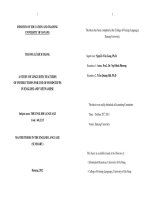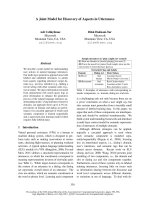Detailed rules for change of tenses in indirect speech
Bạn đang xem bản rút gọn của tài liệu. Xem và tải ngay bản đầy đủ của tài liệu tại đây (12.48 KB, 1 trang )
Detailed rules for change of tenses in indirect speech
When the reporting verb is in the past tense, all present tenses of the direct speech change to corresponding
past tenses.
The simple present tense becomes the simple past tense.
Direct speech: He said, ‘I am fine.’
Indirect speech: He said that he was fine.
The present continuous tense becomes the past continuous tense.
Direct speech: He said, ‘I am writing.’
Indirect speech: He said that he was writing.
The present perfect tense becomes the past perfect tense.
Direct speech: He said, ‘I have finished.’
Indirect speech: He said that he had finished.
The simple past tense in the direct speech becomes the past perfect tense in the indirect speech.
Direct speech: He said, ‘The horse died in the night.’
Indirect speech: He said that the horse had died in the night.
Notes
The tenses may not change if the statement is still relevant or if it is a universal truth. We can often choose
whether to keep the original tenses or change them.
Direct speech: Peter said, ‘I know her.’
Indirect speech: Peter said that he knew her. OR Peter said that he knows her.
Direct speech: The teacher said, ‘The earth revolves around the sun.’
Indirect speech: The teacher said that the earth revolves around the sun. OR The teacher said that the
earth revolved around the sun.
Notes
The past tense is preferred when it is not certain whether the statement is true or when we want to report
objectively.
Stay on top of your writing! Download our grammar guide from www.englishgrammar.org to stay up-to-date.
Powered by TCPDF (www.tcpdf.org)









